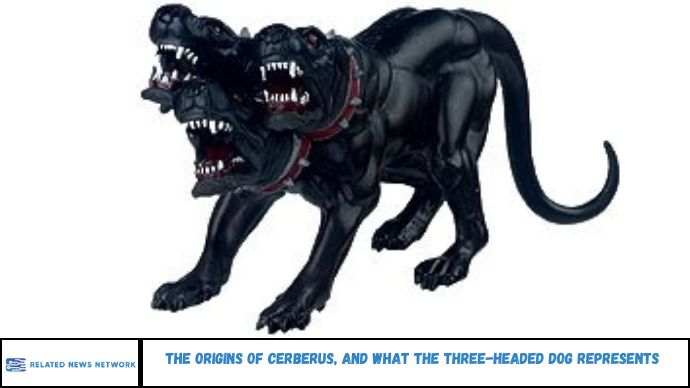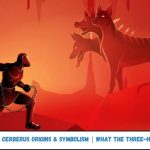What does a massive three-headed dog guarding the gates of the underworld symbolize? In Greek mythology, Cerberus isn’t just a terrifying creature—he’s a powerful symbol rooted in deep cultural meaning. From ancient literary sources to modern interpretations, the story of Cerberus raises fascinating questions about life, death, and the boundaries between worlds.
Origins of Cerberus, what each of his heads may represent, and how his myth has evolved over centuries. We’ll also uncover what this mythological guardian reveals about ancient beliefs and modern interpretations.
The ancient Greeks believed that death was the final threshold every mortal had to cross. After being laid to rest in the earth, the soul was carried by water into Hades—the shadowy realm of the Underworld. There, the dead would linger for eternity, slowly fading from memory as time marched on.
While Greek views of the Underworld evolved through the centuries, one truth remained unshaken: the divide between the living and the dead was absolute. No soul could return once it had passed through—nor could the living intrude. Standing guard over this unbreakable boundary was Cerberus, the terrifying three-headed hound of Hades, whose sole purpose was to keep the worlds apart.
Abstract
Cerberus, the three-headed dog of Greek mythology, is more than a monster guarding Hades. His myth reveals ancient Greek views on death, loyalty, and the soul’s journey. This article traces Cerberus’ origins, symbolic meanings, and ongoing relevance in mythology and pop culture.
Who Was Cerberus in Greek Mythology?
Cerberus is a legendary creature that stands at the entrance to Hades, the Greek underworld. He is most famously known as the watchdog of the afterlife, preventing the dead from escaping and the living from entering without permission.
- Parentage: Cerberus is the child of Echidna (half-woman, half-snake) and Typhon (a monstrous giant)—two of mythology’s most fearsome beings.
- Siblings: He shares his monstrous bloodline with creatures like the Chimera, Hydra, and the Sphinx.
According to Hesiod’s Theogony, Cerberus had 50 or even 100 heads, but classical representations settled on three heads, a serpent’s tail, and sometimes snakes protruding from his back.
The Three Heads: What Do They Represent?
The exact meaning behind Cerberus’ three heads is open to interpretation, but scholars and mythologists offer compelling theories:
1. Past, Present, and Future
- Symbolizes time and fate, guarding all stages of life and death.
2. Birth, Life, and Death
- Reinforces his role as the boundary keeper between existence and the afterlife.
3. Mind, Body, and Soul
- A more philosophical lens, suggesting that Cerberus protects the unity of human existence beyond death.
Fun Fact: In Dante’s Inferno, Cerberus appears as a gluttonous beast, a departure from his Greek role as a gatekeeper.
What Cerberus Represents in Mythology
Cerberus isn’t just a scary dog—he embodies several key symbolic meanings:
Loyalty and Duty
- Despite his terrifying form, Cerberus is loyal to Hades and his duty to guard the underworld.
The Inevitability of Death
- Cerberus’ constant watch at the gates of Hades reflects the unchangeable nature of death.
Protection of the Natural Order
- He ensures souls remain where they belong, protecting both the living and the dead.
Famous Myths Involving Cerberus
Heracles and the Twelfth Labor
- Perhaps the most famous story involving Cerberus is Heracles’ final labor, where he was tasked to capture Cerberus without weapons.
- This shows human bravery against death and the taming of fear.
Orpheus and Eurydice
- Orpheus lulled Cerberus to sleep with music, symbolizing the power of art to transcend death.
Cerberus in Modern Culture
Cerberus still appears in films, video games, books, and even company logos. Whether in Harry Potter’s “Fluffy”, the Resident Evil franchise, or Dungeons & Dragons, Cerberus continues to inspire awe and fear.
Stat: A 2022 survey on Greek myth in pop culture found Cerberus to be among the top 5 most recognized mythological creatures.
FAQ
1. What is Cerberus’ origin?
Cerberus comes from Greek mythology, born to Echidna and Typhon.
2. Why does Cerberus have three heads?
The three heads symbolize time, the human condition, or the stages of life and death.
3. What does Cerberus guard?
He guards the entrance to Hades, preventing souls from leaving.
4. Was Cerberus ever defeated?
Yes, Heracles captured him in his final labor without using weapons.
5. Is Cerberus evil?
No—he’s a loyal guardian serving Hades, not a villain.
6. Does Cerberus appear in modern media?
Yes, frequently in movies, games, and literature as a symbol of power or protection.
Conclusion
Cerberus is more than a terrifying beast—he’s a powerful metaphor for the mysteries of life and death. His three heads invite reflection on our past, present, and future, while his role as the eternal guardian shows how ancient cultures understood the importance of respecting the boundary between life and the afterlife.
As mythology continues to inspire stories across generations, Cerberus remains a timeless figure of loyalty, power, and the unknown.







